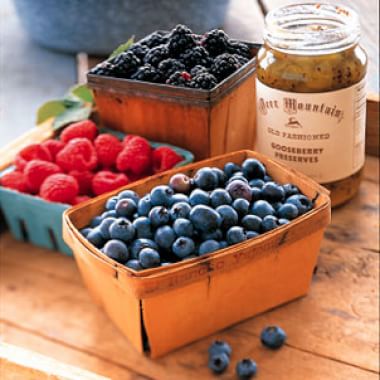
Blackberry
Blackberries are sweetest when completely black. When immature, they are green or red. Blackberries are in season from late spring to early autumn and are best in high summer. Among the most fragile berries, blackberries should not be refrigerated for more than a day. Olallieberries are a kind of blackberry, and boysenberries and loganberries are blackberry hybrids. They may be freely substituted for one another or combined in recipes.
Blueberry
Blueberries are in season from late spring to late summer. They are dark blue and should have a powdery white bloom. When the bloom is gone, the berries are too old. Blueberries can be refrigerated for up to 1 week. Wild blueberries from Maine (which are now domesticated as well) are smaller and darker than ordinary blueberries and are usually very sweet. While they do not travel well, they are increasingly available frozen.
Boysenberry
This blackberry hybrid is a little larger and more purple to red hued than other cultivated blackberries. Boysenberries are preferred by some because of their sweet-tart flavor, juiciness and large size.
Cranberry
Native to North America, cranberries are harvested throughout the fall, with most of the crop being processed into sauce and juice. Cranberries are too tart to eat raw on their own but lend themselves to savory and sweet preparations, marrying nicely with other fruits, such as apples and pears, and with nuts and grains. Fresh cranberries should be plump, firm and dry and range from deep scarlet to light red. Refrigerate for up to 1 month or freeze for up to 10 months.
Currant
The red currant is grown in the United States, while both red and black currants are available in northern Europe. Since both are high in pectin, a natural jelling agent, most currants wind up in jams, preserves, jellies and syrups. Perfectly ripe currants are slightly tart so are usually sweetened before they are eaten. Fresh currants are in season from early July through early August but are difficult to find in markets. Buy small, firm berries and refrigerate them for no longer than 2 days. So-called dried currants are actually dried grapes, or raisins.
Gooseberry
This small berry, resembling a white-striped grape, is pale green and quite tart when underripe; when ripe, it is gold, red, pink, white or dark burgundy. Ripe gooseberries can be eaten straight from the plant, although they are sometimes very tart. Underripe berries are cooked and sweetened for making preserves, sauces and pies. The berries are not readily available in U.S. markets but are popular in Europe. Choose large, firm berries and refrigerate for up to 3 days.
Huckleberry
Close relatives of the blueberry, huckleberries, also called whortleberries, tend to be seedier and a little tarter and are not cultivated. One variety grows on the East Coast and another on the West Coast, with the latter being a true berry and the former a drupe, or a fruit with a center seed.
Loganberry
A blackberry hybrid developed in California, this berry was named after a Santa Cruz judge, James Logan. Loganberries are large and cone-shaped, more purple than black and decidedly juicy.
Marionberry
Another blackberry hybrid, often sold simply as "blackberries," marionberries are sweet and firm enough to hold up in baking and in desserts.
Mulberry
These fragile berries with a sweet-sour flavor are rarely sold commercially. When ripe, they fall from the bush or tree and are gathered off the ground, mostly in home gardens. They look much like blackberries but come in white and red as well as black.
Olallieberry
This large, fragrant blackberry hybrid grows in California and is sweet and juicy. Because they are fragile and do not travel well, olallieberries are not usually available outside their region. They are most commonly found at farmers’ markets or at pick-your-own farms.
Raspberry
Fragrant and subtly sweet-tart, raspberries grow on low, thorn-laden shrubs and have been cultivated for hundreds of years. They can be red, black or golden. All taste similar and are extremely delicate, with hollow centers. Eat them as soon as possible after purchase. Raspberry season extends from June through October.
Strawberry
Bright red berries bursting with sweet flavor and a heady fragrance, strawberries are best in the spring and early summer. Shop for them at farmers’ markets, looking for smaller berries, preferably organic, with a rich, glossy red color and shiny green leaves. Avoid berries with white or green shoulders and brown or limp leaves. Tiny strawberries called wild or wood strawberries, or fraises des bois, are especially sweet. Hull strawberries before freezing them or using them for most preparations.
Adapted from Williams-Sonoma Kitchen Companion: The A to Z Guide to Everyday Cooking, Equipment and Ingredients (Time-Life Books, 2000)








